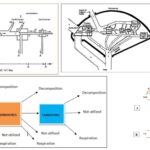Biotechnology 37 Views 1 Answers
Sourav PanLv 9August 20, 2024
In a chemostat operating under steady state, a bacterial culture can be grown at a dilution rate higher than maximum growth rate by (A) partial cell recycling (B) using sub-optimal temperature (C) pH cycling (D) substrate feed rate cycling
In a chemostat operating under steady state, a bacterial culture can be grown at a dilution rate higher than maximum growth rate by
(A) partial cell recycling
(B) using sub-optimal temperature
(C) pH cycling
(D) substrate feed rate cycling
Please login to save the post
Please login to submit an answer.
Sourav PanLv 9May 15, 2025
Answer: (A) partial cell recycling
In a chemostat, partial cell recycling allows the culture to maintain a higher dilution rate than the maximum growth rate by retaining some of the biomass, effectively increasing the total biomass concentration and extending the effective growth rate of the culture. Other options do not typically achieve this.
0
0 likes
- Share on Facebook
- Share on Twitter
- Share on LinkedIn
0 found this helpful out of 0 votes
Helpful: 0%
Helpful: 0%
Was this page helpful?




